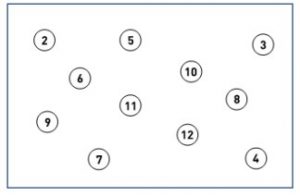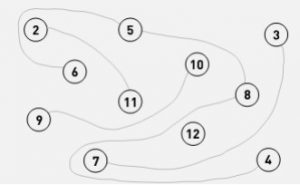Introduction to The Maze Game
I love this game. It’s so simple to play and can be used in so many ways at home or in the maths classroom. All, you need is a pen and paper
I invented it when my kids were both young and I was looking for a fun way to help them read numbers. But there are loads of other applications for the game.
How to play
Let’s imagine that you have a child who needs to practise reading numbers 1-12.
 You write numbers 1-12 on a piece of paper. The numbers should be spread out randomly on the page, not too close to the edge.
You write numbers 1-12 on a piece of paper. The numbers should be spread out randomly on the page, not too close to the edge.
The first thing you do is ask the child to read the numbers. This gives you chance to identify which ones they know confidently and which ones they need to practise. As each one is read successfully, you circle it.
When all the numbers are circled, players take it in turns to issue a challenge to take the pen and to join up any two of the numbers. You can reuse numbers as many times as you like. The only rule is that as you join the target numbers, you cannot touch any other line on the page.
 At first it is easy to join numbers. But gradually with more and more lines on the page, it gets harder. Eventually a player loses the game if they accidentally touch another line, or are given an impossible challenge!
At first it is easy to join numbers. But gradually with more and more lines on the page, it gets harder. Eventually a player loses the game if they accidentally touch another line, or are given an impossible challenge!
This game is super simple but bizarrely popular. Children will play it time and again. Since repetition is necessary for developing fluency in so many areas of maths, this is a bonus. For KS1 children who still need to develop fine motor skills it is also perfect, as they need a steady hand as the game develops to avoid lines already on the page. Whatever your age, everyone likes issuing fiendish challenges to their opponent! I have shared this game in many teacher training sessions, and I have difficulty getting teachers away from it.
Other applications
Once you have got to grips with a straight-forward version of the Maze Game where you are simply reading the numbers on the page, you might start to see other applications for the basic game. Here are some examples.
- You write 24 hour clock times on a page, and require players to give clues using other ways of expressing time. So a player could ask their opponent to join up quarter past three in the afternoon to half six in the evening. The player would find 15:15 and join it up to 18:30
- You write measures in centimetres and require players to give clues in metres or millimetres. So you could ask someone to join up half a metre, to 10 millimetres and they join up 50cm to 1cm
- You put the multiples of seven on a page and require players to give clues in the form of multiplication expresssions. So if the challenge is to join up 56 and 70, the clue would be, “Join 8 x 7 to 10 x 7”
The possibilities for the Maze Game are endless. Do post any new applications for it on our Twitter feed @FunKeyMaths.
Have fun!
